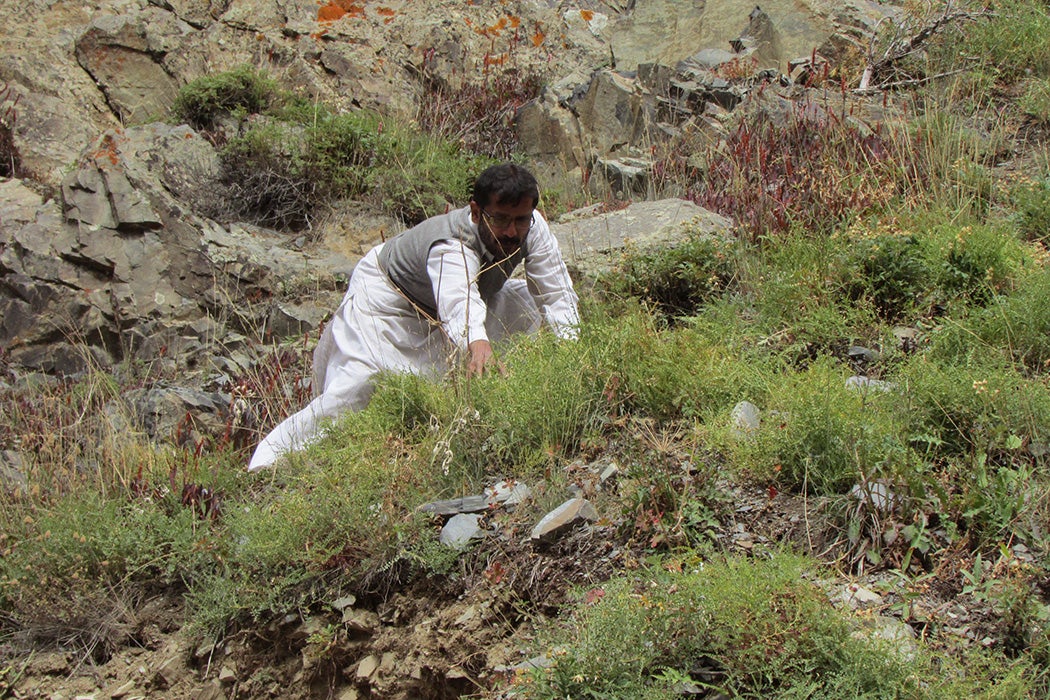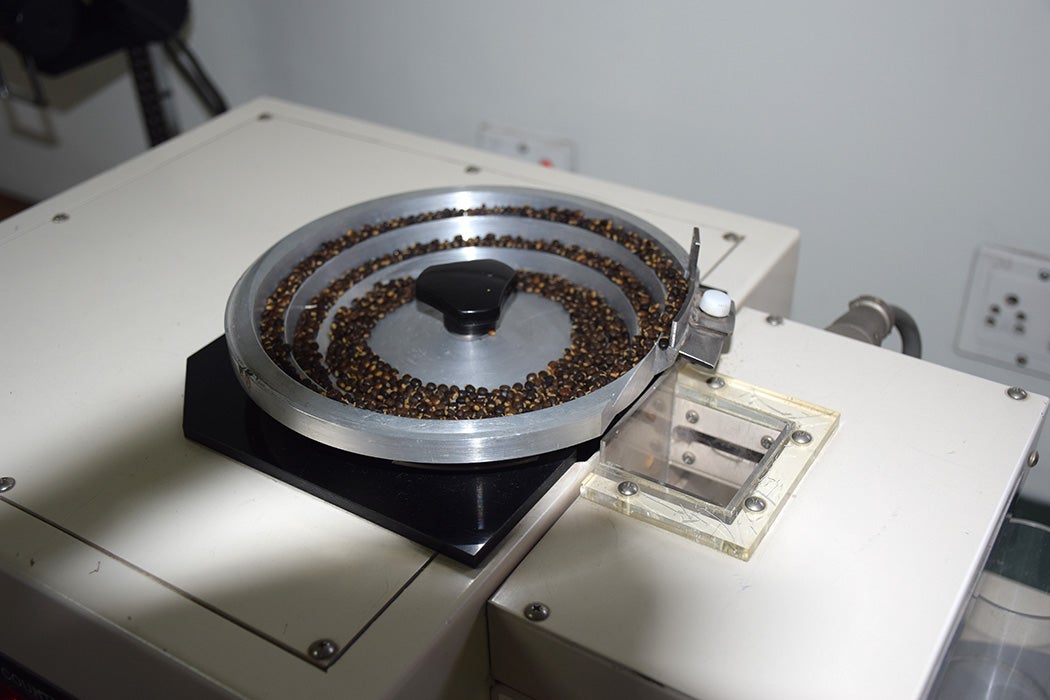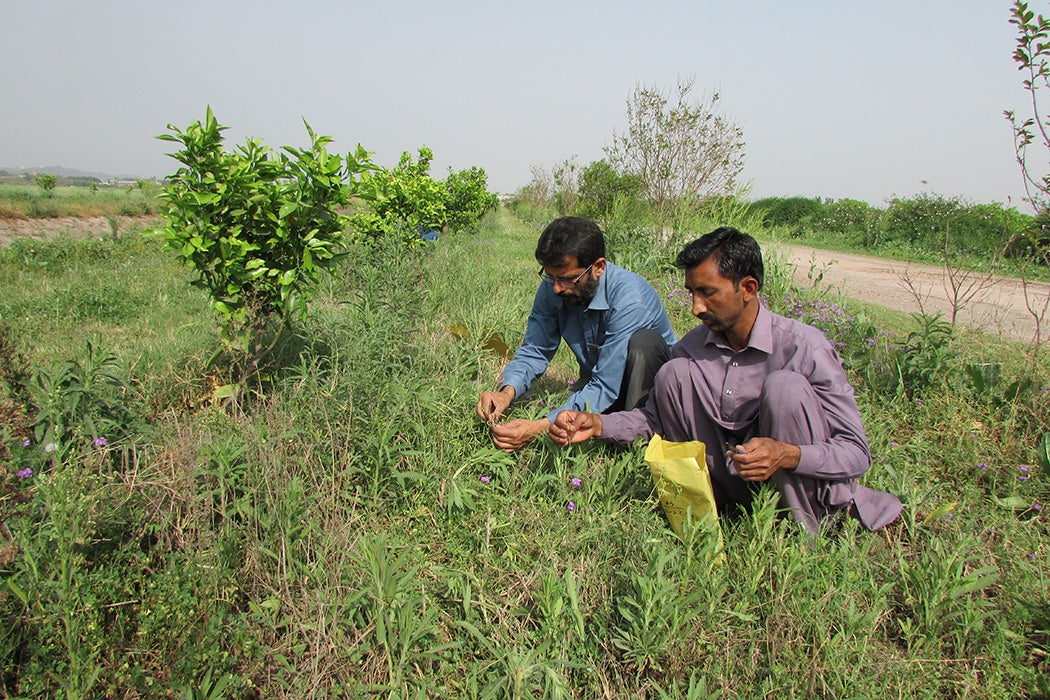In September 2017, when temperatures in Pakistan’s Gilgit-Baltistan region were mild and the thick snow blankets that block passage around the Himalayas later in the season were a still-distant threat, Sadar U. Siddiqui and his companions trekked up through the mountains on a mission to find a wild variety of chickpea. Back in Islamabad, he’d visited the National Herbarium and gotten a good look at the plant species called Medicago sativa subsp. falcata that had sickle-shaped fruit and thin, spiky leaves. If the plant was somewhere out there on the precipitously rocky slopes, Siddiqui, Genebank curator of Pakistan’s Plant Genetic Resources Program (PGRP), had yet to find evidence of it.
One day, though, driving along “no roads, only dangerous jeep tracks” as the afternoon waned, Siddiqui and his companions spotted a goat “finding something to eat,” he says. That something was Medicago sativa subsp. falcata. The goat had ravaged the shrubby clump of plants until all that remained were a few pods and leaves. Siddiqui and his companions—taxonomist Amir Sultan and biologist Shakeel Ahmad Jatoi—chased the animal off. They poured seed from two or three of the remaining pods into paper sacks and counted themselves lucky. Jatoi had gone on a similar expedition to Balochistan and had found, rather than Octhochloa compressa and other species, “A housing colony, cemented roads, and not a single plant,” says Siddiqui.
Siddiqui’s efforts ran parallel to those of seed collectors from 24 developing countries in Europe, Africa, Asia, and the Americas, who have spent the last several years in a race against ravenous livestock, habitat loss, and the effects of climate change as they search for wild relatives of crops vital to human diets. The endeavor, called Crop Wild Relatives Project (CWRP) and overseen by the Crop Trust in Bonn and Kew’s Millennium Seed Bank (MSB) outside London, has three phases. Phase one was a gap analysis to identify what critical seeds were missing in gene banks in certain regions. Phase two, which Siddiqui took part in, entailed seed collecting and distribution to international gene banks. Phase three, currently ongoing, focuses on pre-breeding—identifying desirable characteristics in those collected wild seeds.
As phase three begins, the question is: Were these efforts enough to ensure longterm global food security in the face of climactic upheaval?
The Tilt toward Genetic Erosion
For all the evident diversity in your supermarket shopping cart, agriculture has a dirty secret hidden in plain sight. Only nine crops out of a 120 cultivated worldwide supply three-quarters of the energy we get from plant-based foods. A mere three crops—wheat, rice, and maize—supply half of that, according to the UN’s Food and Agriculture Organization (FAO). By comparison, when our ancestors began to transition from a hunter-gatherer lifestyle to agriculture some 13,000 years ago, they were eating thousands of different plants.
Once upon a not-so-distant time, there was also much greater variety in the species of seeds that produced our wheat, rice, and maize. Wheat is the main staple crop in Pakistan, which once grew hundreds of varieties of it. That number has dwindled to 95. Almost all the remaining varieties of wheat were genetically modified to be high-yield and disease-resistant monocultures, and to grow with chemical inputs. This story repeats in many countries—China had 10,000 varieties of wheat in 1949, but only 1,000 in 1970, and considerably fewer now. Chickpeas, barley, lentils, sorghum, pigeonpeas, carrots, apples, millet, alfalfa, sweet potatoes, and rye have all been whittled down to a handful of mostly-engineered species. They’re controlled by massive international agrochemical conglomerates: Dow/Dupont, ChemChina/Syngenta, Bayer/Monsanto.
Weekly Newsletter
This precipitous drop in diversity began in the 1950s and ‘60s, during the Green Revolution. Confronted with a burgeoning global population, governments worked furiously to ramp up crop production in order to feed more people. A super-productive rice breed called IR8, for example, was hailed as a “miracle seed” and credited with staving off starvation in India, even producing enough for export; traditional rice varietals were then abandoned in its favor.
Crop-by-crop, country-by-country, we’ve achieved a worldwide homogeneity—and “genetic erosion.” It’s a massive threat to food security, according to a paper published in 2014 by the National Academy of Sciences that was co-written by Hannes Dempewolf, Crop Trust’s senior scientist. In the words of Indian environmental activist Vandana Shiva, we’ve hit a state of “seed emergency.”
Crop monocultures that rely on chemical inputs are destructive to soil, water, air, and biodiversity, says the Union of Concerned Scientists. Reduced crop diversity is also bad for human health, and has been linked to upticks in conditions of “over-nourishment” like diabetes and obesity. Agriculture is already experiencing negative impacts from climate change—floods, droughts, extreme temperature fluctuations, earlier or later growing seasons, soil erosion, decreased pest and disease resilience, reduced nutritional value of crops. That makes this global monoculture of monocultures, all created from the same genetic building blocks, a few perfect storms or floods or fires away from being wiped out. Our commercial crops lack resistance, and there’s not enough genetic diversity in the seeds we’ve got left to cultivate new strains to fight new battles on our fields.
This is where crop wild relatives, which geneticist Jack Harlan credited with standing “between us and catastrophic starvation on a scale we cannot imagine,” come in. If we can collect enough wild seeds before the goats eat them all, we might regain the diversity we need to develop hardy crops, locally, that can weather whatever future hardships are in store on our rapidly morphing planet.
Why Crop Wild Relatives?
During phase two’s collecting years, CWRP expeditions yielded 4,644 collections, from 371 species and 28 crop gene pools. Some of these are already being pre-bred in their countries of origin; scientists are determining their particular traits and developing germplasm—living genetic material—that can be used to create resilient hybrids. (Notably, not all modified crops are engineered to be, say, Roundup-ready; individual farmers have been selectively breeding seeds to tap their useful properties for millennia.)
Under the International Treaty for Plant Genetic Resources for Food and Agriculture, signatory countries and gene banks agree to freely share seeds to improve crops. Companies making commercialized hybrids from these resources must contribute a portion of profits “to promote sustainable farming or conservation of genetic diversity” in developing countries, according to Science News.

In joining the CWRP, Pakistan “stood out compared to other countries in how the project [got] a conversation going about the importance of crop wild relatives,” says Dempewolf. “It stimulated a national movement to conserve and collect material and use it in pre-breeding.” Over two years, Siddiqui and his team bolstered Pakistan’s depleted seed bank collections with 2 million wild seeds from 32 species of 18 crops.
The effort was fraught with challenges on multiple fronts, though. Siddiqui’s gene bank staff is comprised largely of a shifting cast of temp workers; teaching them basic protocols—like how to not mislabel materials—is an ongoing struggle. The vehicles at his disposal for collecting expeditions (they continue to collect seeds on their own) are prone to breakdowns and his state funders “think it’s luxurious for government servants to buy a double-cab 4-wheel-drive car that can [make it] into the mountains, and not get stuck in sand,” he says.
Help came in various forms from the CWRP. Siddiqui and Jatoi, along with another researcher, travelled to the Millennium Seed Bank for training in seed processing, handling, germination, and viability testing. MSB also compiled a Pakistan-specific collecting guide that provided taxonomical details, info on where plants have historically been found, and when they bloom. Says Kew’s CWRP coordinator Christopher Cockel, such guides “are valuable so you don’t waste so much time going out on speculative trips.”
Siddiqui did find the guide helpful, even though its accuracy could be hobbled by unexpected variables. “Sometimes we couldn’t [collect] seed because they’d matured earlier than expected, and sometimes we found drought conditions [and no seed],” he says. Sometimes, enthusiastic locals unwittingly sent him on long wild goose chases.
Still, the team managed to collect Pakistan’s first-ever wild rice specimen, Oryza coarctata, in a delta near the Arabian Sea. “It was the end of the season and we were not sure we could find anything,” he says. But there the panicles stood in brackish water amid the tides, being munched by buffalo, with what Siddiqui feels sure is a salt-tolerant gene “that will be very important for us” as sea levels rise. Not least because, as a new study out of the University of Minnesota found, in developing countries like Pakistan, crop yields are already plummeting and hunger is inching upward.
Next Steps
Two-thirds of Oryza coarctata and all the seed Siddiqui collected were sent back to MSB. It stores ideally, 10,000 per species and sends about 100 on to crop-specific gene banks. Cereals go to the International Center for Agriculture Research in the Dry Areas (ICARDA), apples, carrots, and peas to the USDA, and bananas to KU Leuven in Belgium—because the world’s banana experts are based there, says Cockel. The gene banks grow out the seeds to actively regenerate them, providing them with enough to work with. Collections of these new lines of seed, which inevitably lose some of their wild traits when regenerated, are sent to the Global Seed Vault in Svalbard, for additional backup.
One-third of Siddiqui’s collected seed remains in Pakistan. The National Institute for Biotechnology and Genetic Engineering in Faisalbad has started pre-breeding a chickpea wild relative; Sargodha University in Punjab is pre-breeding Daucus carota carota, a wild carrot relative. It can take a decade or longer to get them to a point where they can be crossed with modern varieties from there.

What Siddiqui really wants is a pre-breeding lab of his own, to make up for “gaps in our knowledge of how to use crop wild relatives effectively.” He’s got his eye on an x-ray machine like one he trained on at MSB, to determine if seed contain intact embryos that can germinate; and a hyper-efficient Austrian cooling system that uses only 1 kilowatt of energy to keep an entire stored seed collection at optimum temperature.
The collection phase of the CWRP is over. But Siddiqui’s ongoing 12 expeditions a year target, not just wild relatives, but indigenous heirloom varieties grown by small farmers who “continue to play a key role in maintaining biological diversity,” according to FAO. A new accession now growing in PGRP’s botanical garden is a primitive wheat landrace found in Balochistan that contains twice the world average of zinc and iron.
Some critics of the CWRP fear the likes of Bayer/Monsanto using crop wild relatives to usher in a new era of chemical-dependent monocultures. “Rescuing seeds… has effectively configured a ‘use pipeline’ to guide genetic resources away from the farming communities and toward breeders and biotechnologists, whose craft is strongly shaped by private sector interests in sellable seed,” writes Maywa Montenegro in Gastronomica. And although the Plant Treaty stipulates that genetic materials from wild relatives can’t be patented “in the form received,” Montenegro points out that their “derived products” can be. What threats to seed sovereignty—the right to collect, grow, and exchange seed—for non-commercial-scale farmers will that engender?
Dempewolf of Crop Trust maintains that seed collections are a “key public good and that it’s the responsibility of public institutions to get engaged and not leave it to private institutions to do the right thing.” But whether a large-scale model of agriculture can now be built in which agrochemical companies do not dominate, and at a scale that can make a difference, remains to be seen. At the very least, capturing some wild and landrace varietals before they vanish along with “all our genetic inheritance,” as Dempewolf puts it, has been accomplished.







